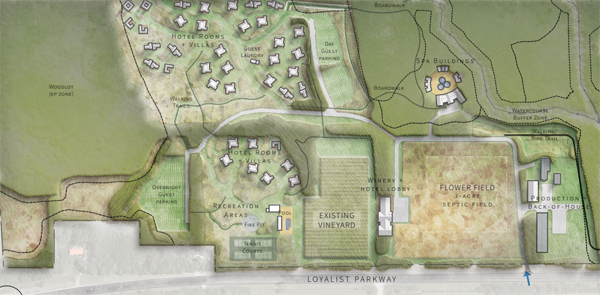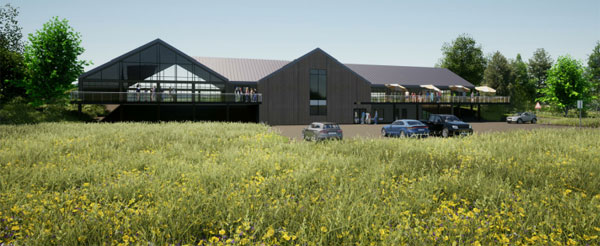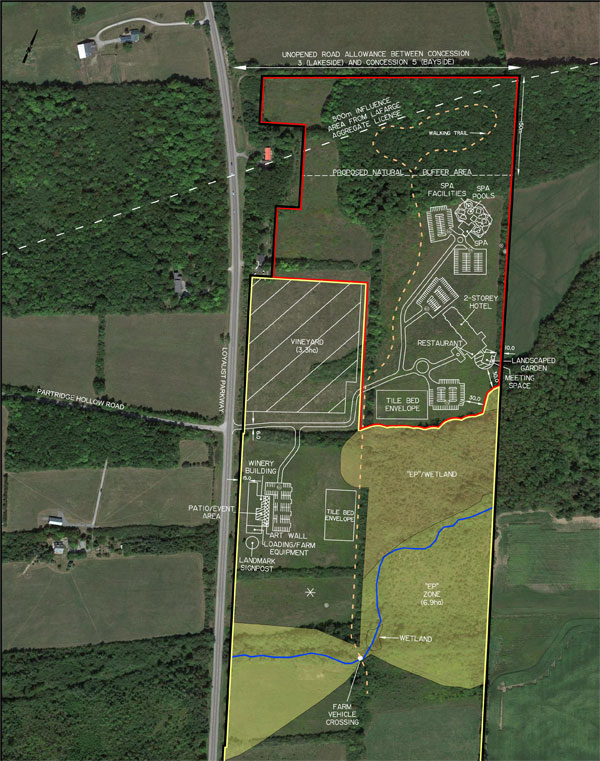First phase of Redtail Winery development gets go ahead
Administrator | Sep 09, 2022 | Comments 3
 The first of two phases of a resort development proposed by Redtail Winery located on Loyalist Parkway in Hillier received council approval at this week’s planning committee meeting.
The first of two phases of a resort development proposed by Redtail Winery located on Loyalist Parkway in Hillier received council approval at this week’s planning committee meeting.
An Official Plan amendment and re-zoning amendment were approved under the old (2006) Official Plan, not the new (2021) Official Plan – since the application was originally submitted in 2019.
 Proposed for the first phase of the development by Redtail owners, Blocknote Canada Inc., south of Consecon is for an estate winery with restaurant, two event venues and retail space, 74 hotel units and a spa with several saunas and pools and a cafe.
Proposed for the first phase of the development by Redtail owners, Blocknote Canada Inc., south of Consecon is for an estate winery with restaurant, two event venues and retail space, 74 hotel units and a spa with several saunas and pools and a cafe.
The second phase of the proposed development, if approved, would see another 74 hotel units added to the existing development.
Half a dozen members of the public, mostly close neighbours, voiced concern on the scale of the development, environmental impact issues, noise and vibration, traffic and parking, species at risk, and the management of the construction period.
 Several also expressed issue with the lack of communication and notification to those neighbours most affected by the re-development of the property, who said they had never been contacted by the municipality or the developer.
Several also expressed issue with the lack of communication and notification to those neighbours most affected by the re-development of the property, who said they had never been contacted by the municipality or the developer.
But it was water consumption required on a year-round, daily basis by the proposed resort in order to operate, in an area known for its insufficient groundwater supply, which drew most concern.
It is proposed 44,000 litres of water per day, every day, will be needed to operate the resort’s proposed first phase, a figure noted by several as “not an insignificant sum”.
“It is absurd that the first phase of this project will use up to 44,000 litres of water a day,” said Janina Barrett whose home borders directly to the south of the proposed development.
“My reading of the reports leads me to believe you cannot pull from the ground 44,000 litres per day over many days and not cause water shortage problems to surrounding land,” she said. “We now know in what seems to be a common drought season, several of our neighbours wells run dry and they have to truck water in.”
Ryan Bent lives on County Road 33 and was also concerned about water consumption of 44,000 litres day per day.
“In phase two, they want to take another 64,000 litres which is 108,000 litres total per day,” said Bent. “I don’t understand how they are going to do it unless they plan on buying water from the neighbours.”
Loyalist Parkway resident Sean Ramesbottom whose property is completely surrounded by the development said he was OK with the initial proposal plans from 2019, but said the the new amended site plan/expansion phases 1 and 2 are concerning. He was also concerned about the length of the construction period.
His overall concerns relate to general quality of life, reduction in property value, general environmental impacts, security and privacy, well water and septic, and “living next to what is arguably the largest tourist facility in the County”.
“I get the pleasure of living next to a parking lot and tennis court and basketball court, I am worried about the on-going phases of construction and noise impact as I work from home,” he said.
He too has issues with the development’s water requirements.
“I ship water to my property 80 per cent of the year; the wells don’t have water,” noted Ramesbottom.
Local resident Dee Hazel lives on nearby Partridge Hollow Road and said water is a huge issue and wanted to know how the development will affect their water supply.
“There is not enough water to service a development a tenth of this size,” expressed Hazel.
“Many residents in the area have to buy water in the dry seasons, including us, and our well is 150-feet and we have a family of two.”
Matt Coffey, co-ordinator, approvals noted if the requirement for water for the development is below 55,000 litres a day in the first phase, a permit would not be required.
“Phase one will be just under the 50,000 mark, phase two will kick it up to 64,000 litres a day and would require a permit to take water,” said Coffey.
Councillor Ernie Margetson said he had heard through comments from the public the importance of having enough water for this type of development.
“I personally don’t accept trucking water as an alternative to having water on site to supply the development being proposed,” Margetson said.
Councillor Janice Maynard asked what can be done to prevent water being trucked in, where Coffey said there is nothing the municipality can do to prevent the developer from trucking in water, if it was required.
“The probability of getting 44,000 litres day in and day out on that property are probably slim to none, let alone 64,000,” Maynard said. “We are not talking about a one-time draw, we are talking about day in and day out.”
Of concern to councillor Jamie Forrester are the septic systems as it pertains to cutting and drilling into limestone and the associated noise to build a system.
“As we build something like this, how do we manage this, and I presume they will want to go down three to four feet if they are cutting through limestone,” Forrester said. “This is major construction that just can’t be done with a shovel, it’s got to be dynamited and drilled out.”
George Degg, a close neighbour, expressed concern over the wind turbine erected on the site two years ago by Blocknote which backs onto his property where his concern is for two species at risk birds, the meadowlark and bobolink, as well as his own health.
He questioned how a hay field, a bird sanctuary, containing species at risk can now have a wind turbine in it, where he notes there was no consultation.
“They destroyed the habitat of that bird by bulldozing it with the parking lot and putting in vines, and they didn’t put any new habitat in for it, how can they do that, it bothers my mind,” said Degg.
“The wind turbine is 200 decibels from my bedroom window,” he said. “The harmonics from those things destroys the bats that live in my barn, and the swallows and martins, those things destroy all that.”
Barrett was also concerned about the wind turbine which she said is not addressed in the noise impact study.
“The wind turbine, which is 125 feet from our door, sounds like a jet engine when it takes off.”
“That turbine is right in the flight path [of the birds], 150 to 200 feet from my property line, and 250 feet from house, it shakes the house,” added Degg.
“It’s like a helicopter landing in your backyard; it’s really noisy, it’s harmful to your health, and once you get over 85 decibels it destroys the hearing in your ear,” he said. “It’s not a noise factor, it’s a health and safety factor, plus an environmental disaster.“
Coffey clarified the wind turbine is not a wind turbine, it is frost fan.
“It is often used in vineyards in the springtime and they come on early in the morning to prevent frost accumulating on the grapes, so they are on a time function and they come on for a brief amount of time,” he said.
Coffey also spoke to the species at risk noting a 2019 environmental impact study completed identified three areas on the field for potentials for species at risk habitat.
“Species at risk under the endangered species act, there are exemptions and agriculture is one of those exemptions,” explained Coffey. “The field is planted with a vineyard, so that exempts them from the environmental endangered species act in those locations.”
“They are proposing to build a vineyard and parking lot on top of the protected lands for two endangered species of birds,” added Bent. “It doesn’t make any sense to me that they would be allowed to do that.”
He also expressed concern about the busyness of County Road 33 already and the difficulty he and his neighbours have in exiting their driveways due to increased tourism traffic.
“It’s insane right now; this proposed monstrosity is going to make that worse for me, it is also dangerous for my kids,” said Bent.
He also brought up the Millennium Trail which crosses his house and asked if a traffic study had been done on it.
“It’s very hard to get across 33 as it is as there is nothing there for any of the ATVs, bicyclists and snowmobilers.”
Adam Layton with Evans Planning, agent for Blocknote Canada Inc., noted the hotel villa, parking areas, winery, restaurant and spa account for a minor percentage of the property, around 10 per cent, and all are located north of the watercourse.
“The majority of the site, well over 50 per cent, is to be maintained as both the agricultural or open space as a natural feature condition, with 0.88 hectares of new feature areas to be replanted,” said Layton.
He noted the setbacks from the watercourse have been assessed.
“While we are somewhat short on the typical 30-metre setback from the watercourse, the conservation policies do allow for a reduction, where warranted, and we are providing a variable setback with at least 21 meters, well exceeding 30 metres in some cases.“
Layton also noted there are no structures within the floodplain.
“At least 13 test wells have been drilled to try to determine water sources, where at least three wells deemed viable and we have concentrated all well drilling to the north side of the site.”
He said the south side planted with vineyards could be explored further.
“We are satisfied there is a sufficient supply of potable water that could support the hotel and spa use,” added Layton.
“It has been noted vineyards do not require any irrigation, and in times of extreme draught, water could be trucked in during the summer months and the production season, if necessary.”
Click here for further detailed background on the proposed development.
Coffey noted the application will require a site plan control application at a later date and he said in addition staff are recommending holding provisions on the zoning applicable to two phases of the development that impact the hotel.
“The reason for the hold is because through the peer review process for the applicant’s hydrological work it was determined additional work is required.”
He said four or five key recommendations were developed from the peer review, along with comments from Quinte Conservation that they would like the applicant to complete before removal of the hold is approved and before a site plan control agreement can be entered into.
“There are some pretty strict requirements on what the next phase of this development is,” added Coffey.
Councillor Brad Nieman said the burning question was whether for site plan approval will not go through delegated authority, but will come back to council.
Coffey responded by noting the site plan approval process is through delegated authority.
“There needs to be a bylaw amendment to remove the hold on each phase, which has potential to come back to council,” clarified Coffey.
Michael Michaud, manager of planning clarified further by saying Bill 109 states site plan approval is delegated to staff and will not come back to council for final approval, something he said is very specific.
“However, the documentation is circulated to council of the site plan so you have the ability to ask questions, find out more information and glean more information from residents,” Michaud said.
Hazel’s concerns also extended to the impacts to the land, the environment, the climate, the trees, and the size of the proposed development which she said is “totally unacceptable”. She also suggested the development was in direct conflict with the Official Plan.
“There are woods and the like in the area, these are robust tree lines for wildlife and for the protection of farmland from erosion, not hotels and spas,” she said. “This proposed development is not compatible with its surroundings, it is not protecting rural habits or the natural environment, and a development of this size will have a huge negative impact on the climate.“
“How could anyone think this type of development and its size is suitable for this rural area?” Hazel asked. “The land is farmland and is environmentally protected, and the protected land will stay protected of course, the farmland will not be.”
Councillor John Hirsch noted the need for this kind of accommodation in the County.
“This is the kind of tourist accommodation that is going to help alleviate the pressure of short-term accommodation issues,” he said. “I can support this project as along as these many problems are dealt with at the site plan control stage, satisfactorily.”
Filed Under: Featured Articles
About the Author:
































I don’t mind the business aspect of operating a spa but the water consumption sounds like a lot. Like alarming so. That 44k litre daily use equates to 16M litres annually – the equivalent of over 6 Olympic sized swimming pools. Will the water use be metered even though it’s from a well? It would be good if there were some comparative water stats (usage and affects of) from other existing rural spas (St. Anne’s eg. ).
Thanks, County Live, for this detailed account of the planning meeting. I’m disappointed that, despite requests being made at a previous public meeting, no recent well water monitoring has been done by the Blocknote/Redtail organization. Removing 44,000 litres of water every day from the groundwater supply will likely have a disastrous effects on local wells – something that the developer and county planners seem to be ignoring.
With a climate emergency in place, and the concerns over water, a simple requirement would be to insist on a water positive model. Simple rainwater catchment, containment, and purification for their large water usage is not difficult. Tapping into the aquifers will impact local residents, farms, watersheds, no doubt.